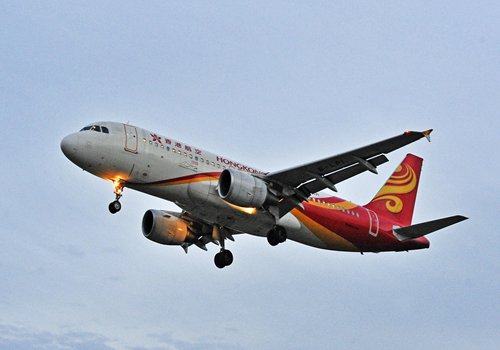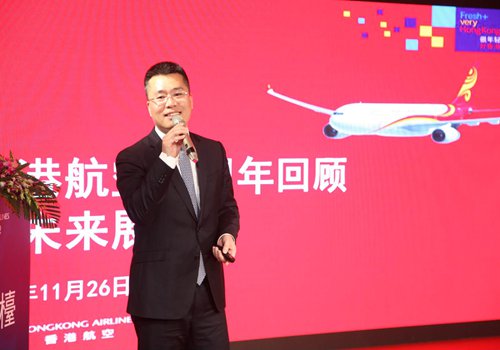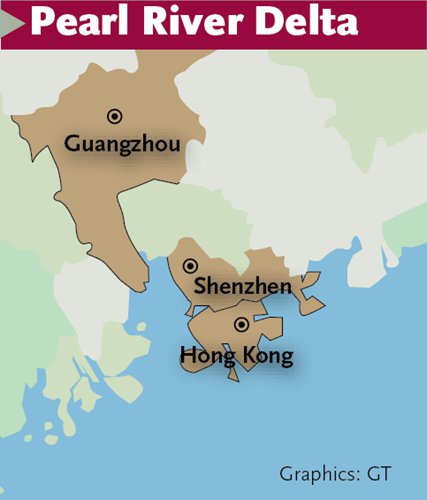
A Hong Kong Airlines flight lands at an airport at Fuzhou, capital of East China's Fujian Province. Photo: CFP

Li Dianchun, chief commercial officer of Hong Kong Airlines. Photo: Courtesy of Hong Kong Airlines

Graphics: GT
Hong Kong has made a name for itself as a pioneer of China's aviation industry.
Home to one of the busiest airports in the world, the tiny region has given Hong Kong Airlines the chance to become a rising star in the industry.
The airline, one of China's youngest, celebrated its 10th anniversary on Saturday in Beijing, where it announced its ambitions not only for the region of Pearl River Delta in southern China, but also for the world.
A subsidiary of HNA Group, Hong Kong Airlines flies to more than 30 cities in the Asia-Pacific region, and has code-sharing agreements with 11 other airlines. As of the end of September, it has transported more than 26.5 million passengers since 2006, with a compound annual growth rate as high as 20 percent according to Hong Kong Airlines.
It is expected to carry 6.6 million passengers by the end of this year, accounting for nearly 10 percent of the Hong Kong market, the airline said.
However, the airline's top concern is how to deal with challenges from competitors within Hong Kong and in neighboring regions.
Competition next door
"Our rise has benefited from the development of the Chinese economy, especially in the region of Pearl River Delta," said Li Dianchun, chief commercial officer of Hong Kong Airlines.
Li said Chinese mainland travelers account for 45 percent of the airline's passengers, the majority of whom come from the Pearl River Delta region.
"Most of our travelers are making transfers. Only 30 percent are making city-to-city flights," Li told the Global Times on Saturday in an exclusive interview.
As one of the busiest aviation hubs in the world, Hong Kong International Airport handled 5.72 million passengers in October, down 0.9 percent from the same period in 2015.
Although its total number of passengers has fallen, the airport remains among the busiest in the world in terms of international flights.
The airport won permission this year to build its third runway, meaning it will be able to handle more flights and more passengers in the future.
However, the growth of the Pearl River Delta region's economy poses challenges to airlines based in Hong Kong.
Guangzhou Baiyun International Airport, home to China Southern Airlines, China's largest carrier by fleet size, plans to increase international slots from the current 23 percent to 30 percent in a few years.
Also, Shenzhen, South China's Guangdong Province, is mapping its aviation market.
With the support of the local government, airlines such as Xiamen Airlines, Air China and Shenzhen Airlines have been flocking to Shenzhen.
In September, Xiamen Airlines launched a route from Shenzhen to Seattle, the airport's first intercontinental flight to the US.
There are 19 overseas flights flying out of Shenzhen, a number that could reach 48 by 2020, according to local official website of szfao.gov.cn.
Li said that the rising number of air travelers from the Pearl River Delta region provide Hong Kong Airlines with a stable flow of customers because its advantage is not only in serving local carriers, but also the Pearl River Delta region, making Shenzhen a good transfer market.
International exploration
Facing competition in southern China, Li said the next strategic step for Hong Kong Airlines is to explore the international market, such as long-haul routes to North America.
Li said the airline will take delivery of an Airbus A350 in 2017. Although he did not say where the new aircraft would fly, it is possible to deploy an A350 on a long-haul flight to North America, which will put the airline in head-to-head competition with another Hong Kong airline, Cathay Pacific Airways.
In the past, Cathay Pacific has dominated routes from Hong Kong to Europe, Australia and North America due to advantages such as its brand name and the size of its wide-body fleet.
Meanwhile, as a newcomer, Hong Kong Airlines has been building a network across the Asia-Pacific region.
In October, Cathay Pacific said it had deployed an A350-900 to Auckland, New Zealand - the airline's third long-haul destination on an A350. Since 2013, Cathay Pacific has been able to operate up to three flights a day between Hong Kong and Auckland.
On November 11, Hong Kong Airlines became the third carrier to link Hong Kong and Auckland with non-stop flights, following Cathay Pacific and Air New Zealand.
This route of more than 9,000 kilometers is Hong Kong Airlines' longest, exceeding its 7,033-kilometer route to Australia's Gold Coast.
Li said the airline has gained one-third of the Hong Kong-Auckland market.
The decision to open a route to Auckland resulted from rising demand on the Chinese mainland, and travelers from Europe to Auckland will choose to transfer in Hong Kong. Travelers from Europe and India have accounted for nearly 50 percent, Li said.
Also, in the North American market, Hong Kong enjoys the advantages of open sky with the US, which means the airline is not bound by traffic rights, Li said.
So far, the traffic rights between Chinese mainland and US have been shared between the carriers from the two countries, as the market is expanding.

